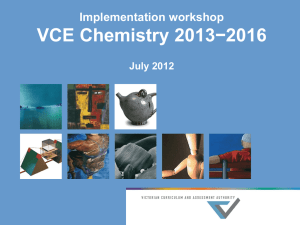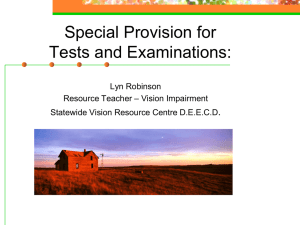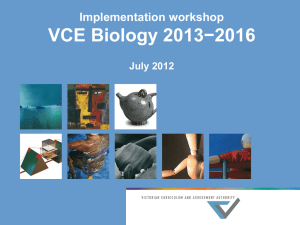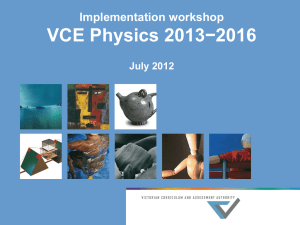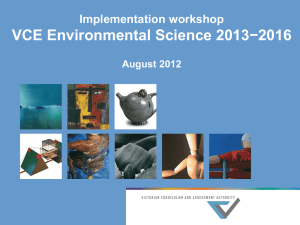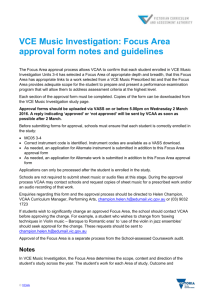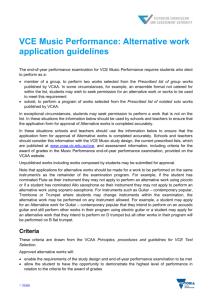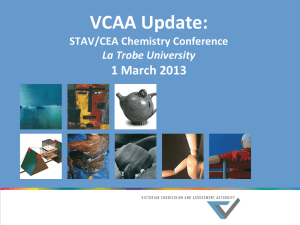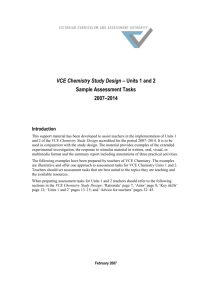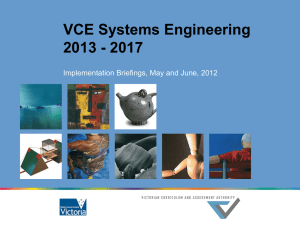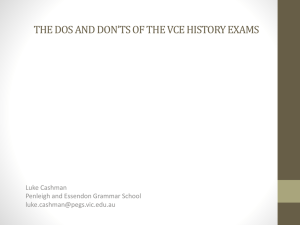VCE Chemistry 2013−2016 - Victorian Curriculum and Assessment
advertisement
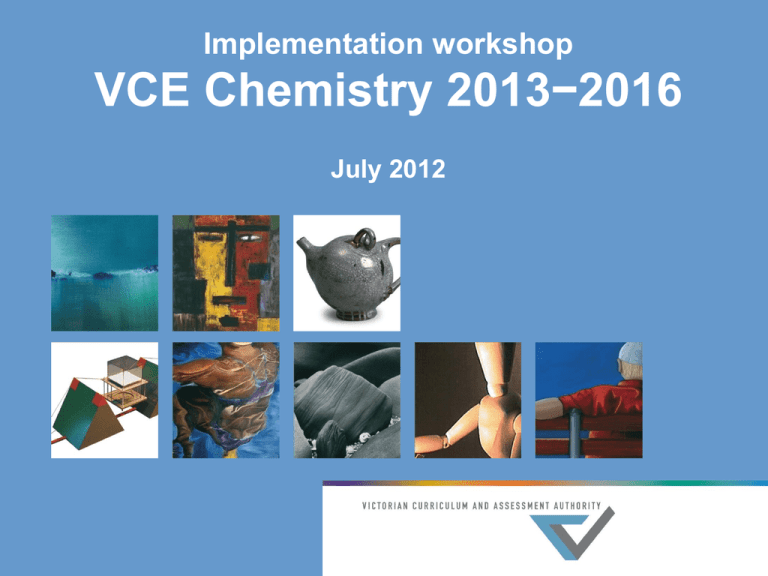
Implementation workshop VCE Chemistry 2013−2016 July 2012 Purpose The aims of this session include: • to provide specific information regarding changes to curriculum and assessment for VCE Chemistry 2013-2016 as a result of a move to a single end-of-year examination of two-and-ahalf hours duration • to gather feedback/questions/comments regarding implementation in order to produce a set of FAQs to support delivery of the revised study design for VCE Chemistry from 2013. Online publication of VCE Study Designs • From 2013, all VCE study designs, advice for teachers, resources and assessment handbooks will be available in an online format only (i.e. no hard copies) • Online publications will include a publication/update date • Teachers will be advised of major updates through the VCAA Bulletin VCE, VET and VCAL Summary of changes A number of key knowledge points across Units 3 and 4 have been edited and expanded for clarity, and changes have been made to School-assessed Coursework. These have been published in the VCAA Bulletin VCE, VCAL and VET Supplement 1, No. 97, July 2012. Reminder: teachers may subscribe to the VCAA Bulletin Online – refer to VCAA home page. Teaching and learning resources • Changes to the study design have been made with the intention that teachers may continue to use existing teaching and learning resources • The Summary of changes for VCE Chemistry on the VCAA website should assist teachers to identify study content and sections in current texts which may no longer be applicable to the accredited 2013–2016 course • Teachers should note that some publishers are producing revised materials. It is a school/teacher-based decision as to whether new resources are purchased and/or utilised Overview of changes Curriculum changes: • Unit 4: students will investigate the production of one industrial chemical selected from ammonia, sulfuric acid or nitric acid (not ethene) – this will be assessed through School-assessed Coursework (SAC) only • editing of key knowledge for clarity and scope Assessment changes: • Single end-of-year examination of 2½ hours duration • Examination:SAC = 60:40 (changed from 66:34) • Minor changes to Unit 3 SAC tasks • Unit 4 SAC tasks and mark allocations have changed Unit 3 Key Knowledge: removal of content Two key knowledge points have been deleted in Unit 3: Unit 3, Area of Study 2 • principles of fractional distillation Unit 3, Area of Study 2 • use of proteins as markers of disease Changed Unit 4 Outcome Current Unit 4, Outcome 1: On completion of this unit the student should be able to analyse the factors that determine the optimum conditions used in the industrial production of the selected chemical (one of ammonia, ethene, nitric acid, or sulfuric acid) Revised Unit 4, Outcome 1: On completion of this unit the student should be able to analyse the factors that affect the extent and rate of chemical reactions and apply this analysis to evaluate the optimum conditions used in the industrial production of the selected chemical (one of ammonia, sulfuric acid, or nitric acid) FAQs A set of Frequently Asked Questions will be published on the VCE Chemistry study page of the VCAA website to support implementation of the revised study design 2013-2016 School-assessed Coursework • contributes 40 per cent to the study score - Unit 3 SAC: 20 per cent - Unit 4 SAC: 20 per cent • should form part of the teaching and learning program, both in terms of formative (including diagnostic) and summative assessment School-assessed Coursework: Study of an industrial chemical Unit 4 – study of the industrial production of a selected chemical may be presented as: a response to stimulus material in written, oral or visual format an analysis of first- or second-hand data using structured questions a report in written, oral, multimedia or visual format Note: It is possible for students in the class to study a different chemical Advice for Teachers • The Advice for Teachers has been updated to include relevant employability skills derived from the Employability Skills Framework against specified assessment tasks for Units 1−4 Assessment Handbook The Assessment Handbook for VCE Chemistry 2013−2016 will be available from the VCE Chemistry study page prior to Term 1 2013. Resources • The list of resources will be updated annually by the VCAA and will be available from the VCE Chemistry page • Educators may submit suggested references for inclusion on the resource list to the Curriculum Manager for Science at the VCAA Examination conditions • 15 minutes reading time • 150 minutes writing time • Question and Answer book + Multiple Choice answer sheet • 60 per cent contribution to Study Score Examination content • All outcomes in Units 3 and 4, and all the key knowledge and key skills, except content related to the study of the industrial production of a specific chemical • Students will be required to apply Chemistry knowledge and skills to both Unit 3 and Unit 4 • Some questions may include content from more than one Area of study within a Unit and/or content which may cross both Units 3 and 4 Examination format Section A • Multiple choice • 30 questions worth 1 mark each Section B • 90−100 marks • All questions compulsory • Variety of question types including questions which require calculations, descriptions and explanations Approved examination materials Approved: • • • Stationery: pens, pencils, highlighters, erasers, sharpeners and rulers Scientific calculator Data book will be provided and will be separate from the exam Not approved: • • Blank sheets of paper Correction fluid or tape Examination advice • Each examination will follow the examination specifications and will test a representative sample of the key knowledge and key skills • The number of marks provides a guide to the complexity of the expected answer/s • Students may be asked to draw upon their practical experience when answering questions Sample examination paper • • • • • Sample examination paper is composed largely of past examination questions Solutions to past examination questions can be accessed by referring to the relevant Assessment Reports available on the VCAA website Some questions were specifically developed to illustrate that questions can draw upon understanding of concepts across Units 3 and 4 Students may be asked to draw on their practical experience when answering questions Sample examination paper will be published on the VCE Chemistry study pages of the VCAA website Contact VCAA branch Science Manager Contact Details Curriculum Maria James Tel: 9651 4655 Email: james.maria.m@edumail.vic.gov.au Assessment Kris Allen Tel: 9225 2356 Email: allen.kristin.m@edumail.vic.gov.au © Victorian Curriculum and Assessment Authority 2012

